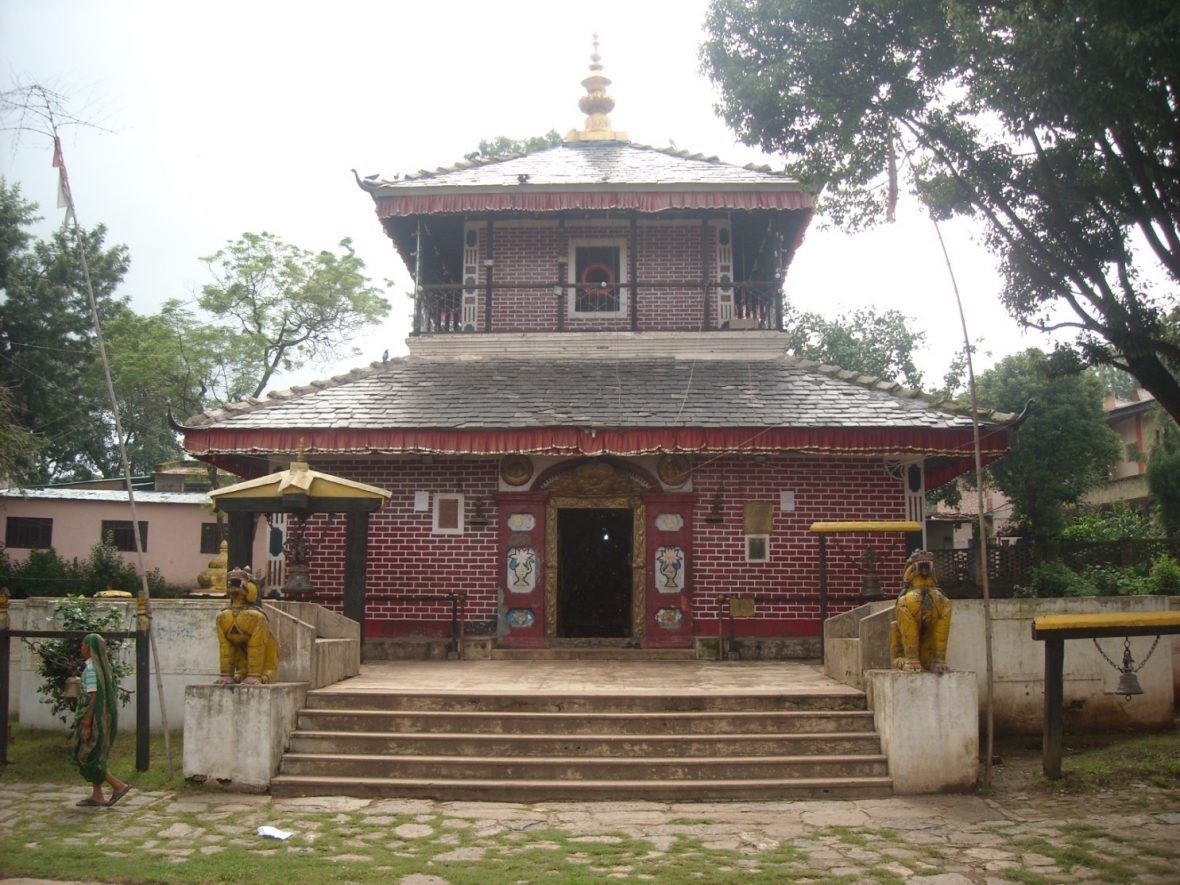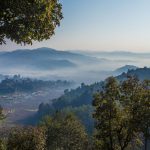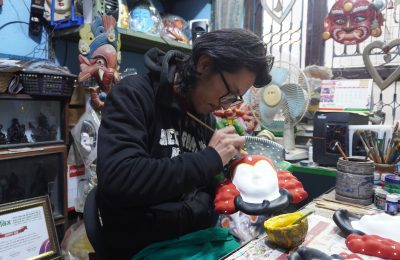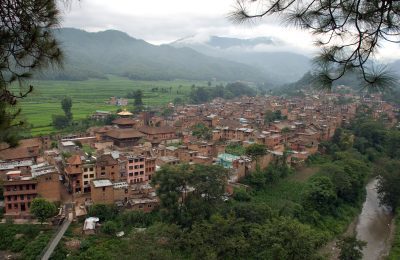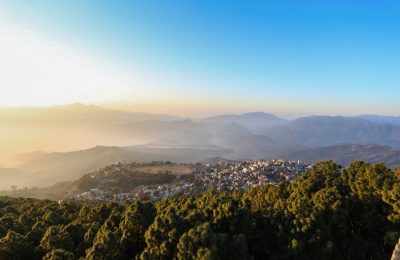The introduction
Bhagwoti Temple is one of the most important shrines of Tansen, Palpa dedicated to Goddess Bhagwoti, the patron deity of Palpa. Today, this Temple stands as a victory monument reminding the people of Nepal’s victory over the British India in 1815 A.D. under the command of Colonel Ujir Simha Thapa in the battle front of Jeetgadhi in Butwal, 39 km south of Tansen. This victory led to the signing of Sugauli Treaty in 1815 A.D. between Nepal and British India, which recognized Nepal for the first time as a Sovereign State.
The Temple History
Before constructing the Rana Ujeshwori Temple (Bhagwoti Temple) in its current form, people built a small temple with the stone image of Mahishasurmardini inside. Mahishasurmardini is one of the names given to the Goddess Durga after she killed Mahishasur, the demon in the form of a buffalo.

The story of present Temple of Rana Ujeshwori goes like this. In the 18th Century the British India attacked Nepal with the intention of capturing its western part. One such attack was made in Butwal, a place now 39 km south of Tansen. The higher authorities ordered the Commanding Colonel of the Nepali Army in Palpa to lead the war from Nepal’s side.
Before setting out for the battle front of Butwal Colonel Ujir Simha Thapa touched the foot of the Mahishamardini. He then vowed to build a Temple bigger in size, organize a chariot carrying procession of Goddess Bhagwoti through the town to commemorate the victory and propagate the glory of this Goddess if he wins the battle. As desired, Nepal won the battle with the grace and blessing of the Goddess Bhagwoti.

As vowed, Colonel Ujir Simgh Thapa rebuilt the 3 tiered Temple in bigger size with a pinnacle. He placed the old stone image of the Goddess inside the Garva and installed the 18 armed metal image of Mahishamardini made of 8 different metals ingredient. He inaugurated the chariot procession of Goddess Bhagwoti on Monday, 19th Ashad 1877 B.S. on the day of Krishnanawami. Since then this Temple has become famous with the name Rana Ujeshwori Bhagwoti.

Symbol of Religious harmony
The Rana Ujeshwori Temple is managed by a committee comprising of people from different walks of life and Government representative of Palpa district. While the Bhagwoti Temple is basically a Hindu religious shrine, the priests come mainly from Gubhaju family who follow Bajrayana sect of Buddhism. They perform the worship and rituals of Goddess Bhagwoti in Tantric system. Peoples from both religions pay equal respect to Goddess and visit the Temple frequently and freely for worship. So this Temple stands as the symbol of religious harmony and tolerance for the people of Palpa district. Additionally, every followers of Hinduism can submit offering to the Goddess on board the chariot in procession regardless of their social class and cult.
Owned by the Nepali Army
The Bhagwoti chariot procession is associated with the Nepali Army’s victory over the British India. As such, Nepali Army carried on the maintenance work of the Temple till 2015 BS and resumed the work again in 2063 BS. Since then the Nepali Army has been, as required, carrying on the maintenance works of the temple.

After realizing the importance of Nepali Army’s glorious past attached to this event and sovereignty of Nepal, it has gradually begun to own the festival. As a result, Nepali Army now participates actively in the preparation of the festival and for the chariot procession by sending a contingent of its soldiers, a musical band and a small unit of Nepali Army in the attire of King Prithvinarayan Shah’s time.
State Recognized Festival
Today the Nepal Government has recognized Bhagwoti chariot procession as the State festival the only one of its kinds in Nepal. This victory assumes great significance to Nepal as this compelled the British India, the world’s biggest colonial power, for the first time to recognize Nepal as a sovereign State in the Sugauli Treaty.
The Bhagwoti Festival
In the night of Krishnajanmasthami that falls somewhere in the third week of August, the small image of Goddess Bhagwoti is taken out from the main Bhagwoti temple and placed inside the chariots by the priest of the temple after performing special rituals. Then, the Commanding Colonel of Nepali Army in Palpa takes one round of the Temple accompanying the chariot.

Chariot Preparation and Rituals
The chariot is then placed on the ground in front of the Temple. Following this the Commanding Colonel of Nepali Army in Palpa lay the Khadga (41″ long, 3″ wide and 1.200 kg sword) used by Colonel Ujir Simgh Thapa inside the chariot.
The Chief District Officer of Palpa, Commanding Colonel of Nepali Army in Palpa and Chairman of Bhagwoti Temple Management Committee offer Panch Bali (the sacrifice of 5 different animals) as special worship to the Goddess. While the buffalo is sacrificed in front of the Temple where the chariot is placed, the remaining animals are sacrificed inside the Temple.

The next day morning, on Bhadra Krishnanawami, the Nepali Army of Palpa district offers gun salute to the Goddess immediately before the chariot is lifted. The chariot is then made to circle three times of itself by the carriers, the Kumal, the pottery makers from nearby village of Ghorebanda, who are specially employed for this purpose.
The devotees and volunteers also assit the Kumals in performing this task. In the last round of the chariot procession, The Commanding Colonel of Nepal Army in Palpa offers sacrifice of a he-buffalo and a he-goat to the Goddess while the chariot is in the standing position. A gun salute is offered at this time. This act of sacrifice is called Colonel’s sacrifice – just as Colonel Ujjir Singh Thapa performed in his time.
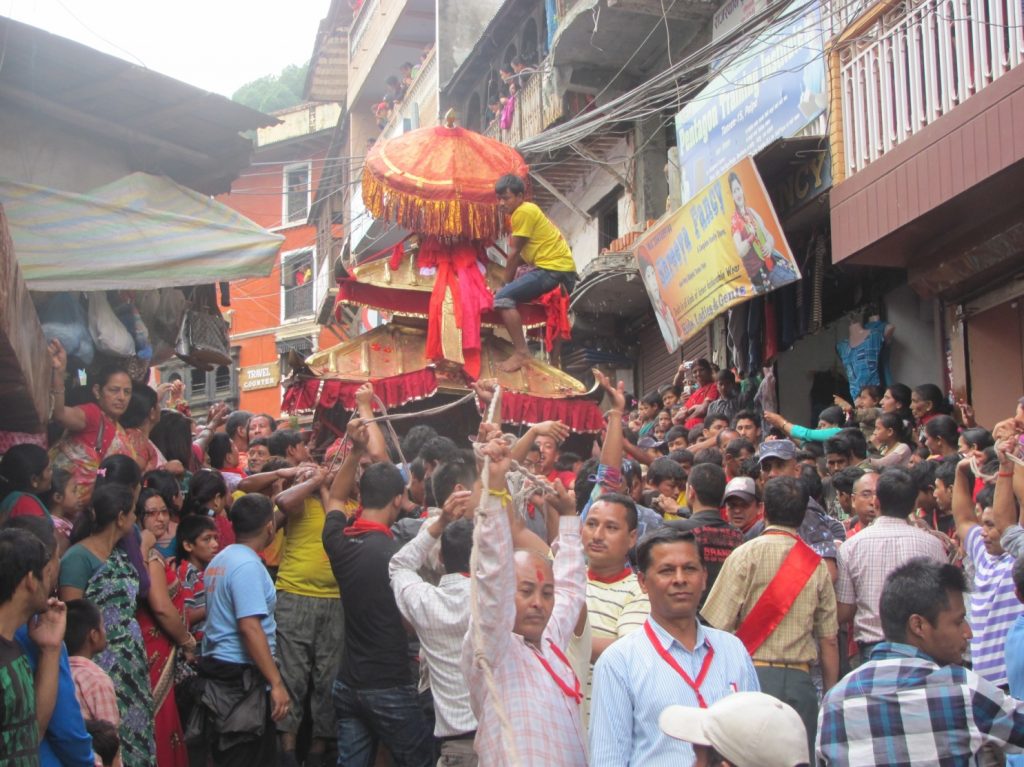
Chariot Procession Highlights
The chariot is then proceeds towards the Tansen Durbar compound where the Chief District Officer of Palpa District offers the sacrifice of a he-goat to the Goddess in the standing chariot. This sacrifice is made on behalf of Nepal Government.
On the way, the chariot arrives at the Nagpokhari, the Nepali Army base below Tundikhel. Here, the commanding Colonel of the Nepali Army in Palpa sacrifices a he-goat to the Chariot Goddess, as an offer by the Nepali Army.
After the chariot procession completes its tour of Tansen, in which it passes by every house accepting worship to the Goddess on board the chariot, it is brought back to the Temple and laid down in front of its main gate. After the priests of the temple complete certain rituals the chariot procession comes to an end. Finally, the priest of Bhagwoti Temple distributes the offerings laid on the pinnacle of the chariot to the devotees assembled there.
Conclusion and Ritual Conclusion at Rana Ujeshwori Bhagwoti Temple
The offerings thus received are kept by the devotees in the sacred area of their house with the belief that this will bring good luck and prosperity to them. Finally, the image replica of the Goddess in the chariots is carried by the priest inside the Rana Ujeshwori Bhagwoti Temple to be kept there for the usual next year’s chariot procession.
Book your Tansen Palpa Community Homestay
Read more about what Tansen Palpa is Famous For
Inspired? Why not have a look at what Royal Mountain Travel can offer to visit Tansen:


